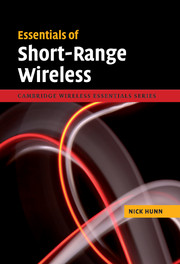Book contents
- Frontmatter
- Contents
- 1 Introduction
- 2 Fundamentals of short-range wireless
- 3 Wireless security
- 4 Bluetooth
- 5 IEEE 802.11abgn/Wi-Fi
- 6 IEEE 802.15.4, ZigBee PRO, RF4CE, 6LoWPAN and WirelessHART
- 7 Bluetooth low energy (formerly Wibree)
- 8 Application development – configuration
- 9 Application development – performance
- 10 Practical considerations – production, certification and IP
- 11 Implementation choices
- 12 Markets and applications
- Glossary of acronyms and abbreviations
- Index
- References
9 - Application development – performance
Published online by Cambridge University Press: 10 November 2010
- Frontmatter
- Contents
- 1 Introduction
- 2 Fundamentals of short-range wireless
- 3 Wireless security
- 4 Bluetooth
- 5 IEEE 802.11abgn/Wi-Fi
- 6 IEEE 802.15.4, ZigBee PRO, RF4CE, 6LoWPAN and WirelessHART
- 7 Bluetooth low energy (formerly Wibree)
- 8 Application development – configuration
- 9 Application development – performance
- 10 Practical considerations – production, certification and IP
- 11 Implementation choices
- 12 Markets and applications
- Glossary of acronyms and abbreviations
- Index
- References
Summary
In the previous chapter we looked at some of the parameters that affect the choice of a wireless standard. This chapter explains how to get the best performance by tailoring it for the specific implementation. It explains the trade-offs that can be made for some of the common parameters in a wireless design. As before, many of the comments and techniques are valid across the range of standards.
9.1 Range and throughput
Invariably, the first question that is asked is, ‘What is the range?’ In Chapter 2, I looked at the fundamentals of range, which are essentially: transmit power, receive sensitivity and matching. In this chapter, I'll look at how to put them into practice and discuss the other key influence – the choice of antenna.
9.1.1 Power amplifiers and low noise amplifiers
The first thought of most designers coming to wireless is how to shout louder; in other words, how they can add additional amplification to boost the transmit power. A number of points should be borne in mind when doing this:As the radio link is symmetrical (i.e., each radio needs to receive as well as transmit), increasing the output power only gives a real benefit if it is done at both ends, otherwise the second radio will not be able to transmit at a level that allows the first unit to hear whether or not its transmissions have been received. It is back to the issue of asymmetric link budgets.
- Type
- Chapter
- Information
- Essentials of Short-Range Wireless , pp. 239 - 263Publisher: Cambridge University PressPrint publication year: 2010



